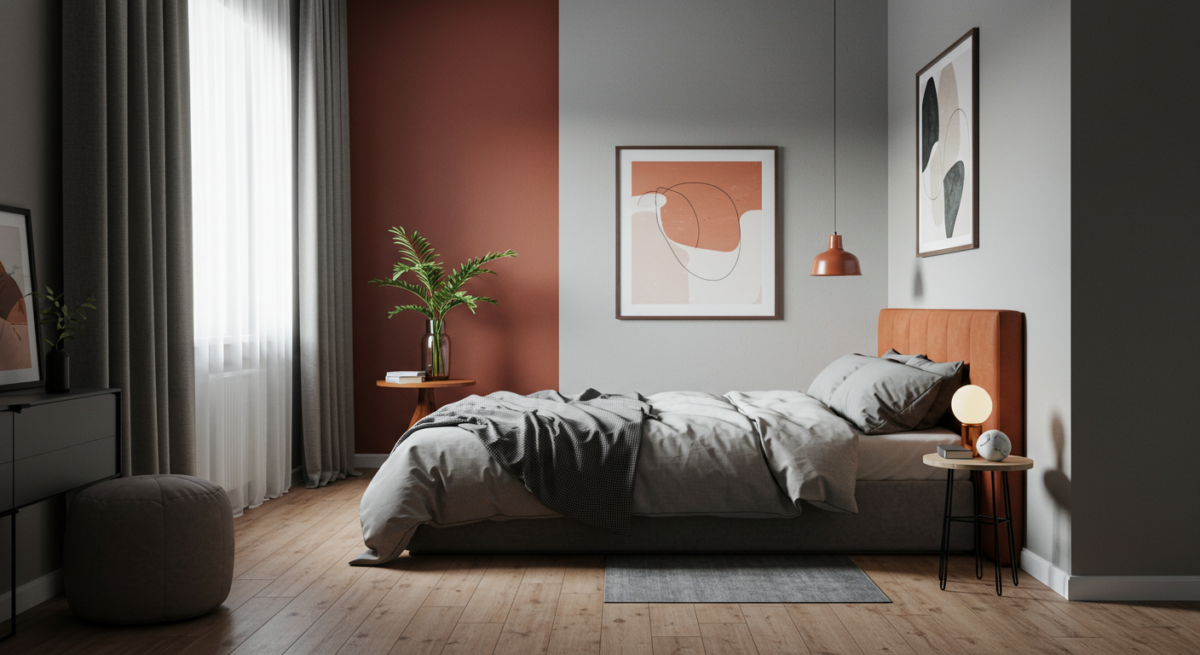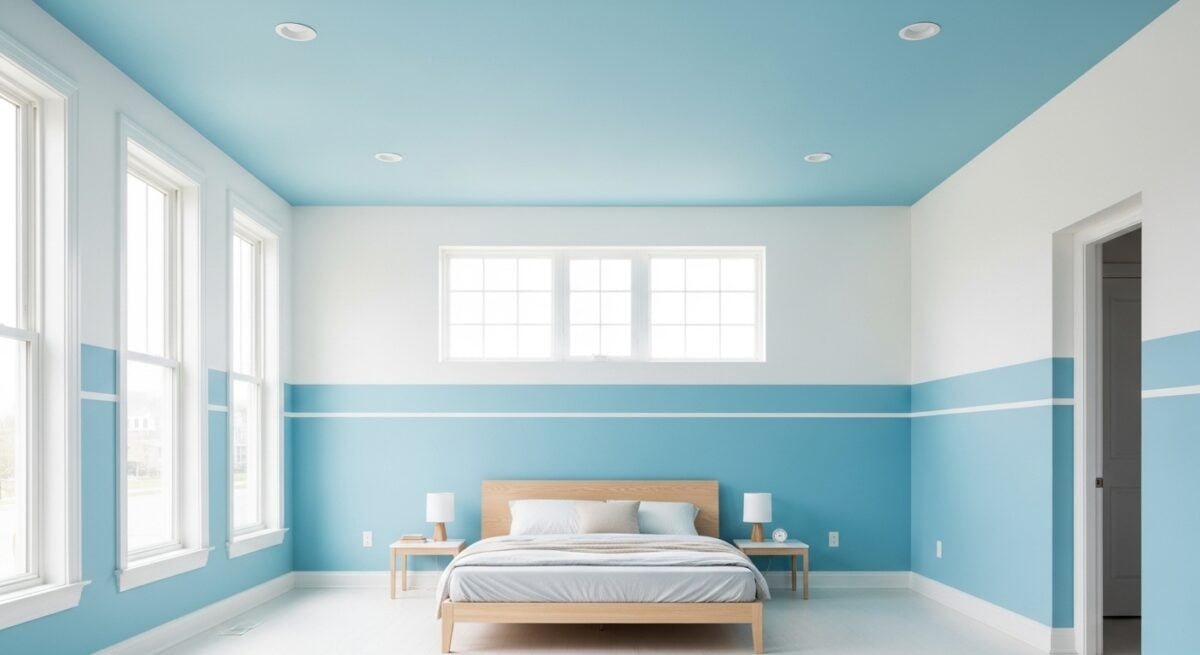Sleep Talk Blog, Inspire me
How to Master Colour Capping: The Latest Decorating Trend Your Bedroom Needs
Table of Contents
Have you ever walked into a room and felt completely wrapped in its atmosphere? That sense of being perfectly enveloped doesn't happen by accident. It's the magic of colour capping - and it might just be the Weekend Project your bedroom has been waiting for.
Interior designers now call ceilings "the fifth wall" - and this shift changes everything about how we approach decorating trends in our homes.
Colour capping works by using a graduated wash of tonal shades that flows seamlessly from your walls up to the ceiling. This clever technique creates what experts call a "stunning, seamless, and enveloping effect," because it removes that harsh visual break where your wall meets the ceiling.
The result? Your bedroom feels both more intimate and more spacious at the same time.
Why has colour capping become one of the most talked-about bedroom trends right now? Simply put, we're craving cosiness and warmth in our personal spaces more than ever. When you bring that often-forgotten fifth wall into your colour scheme, you create a flow that makes your room feel thoughtfully designed rather than accidentally decorated.
Even if you love neutral palettes, colour capping can work beautifully for you. Picture an off-white wall capped with a slightly deeper, more saturated tone of the same shade. This subtle approach gently highlights period details like cornicing whilst making your ceiling an active part of your room's story.
Here's what makes colour capping particularly brilliant: "it's a clever way to refresh your home and achieve a high-end look with just a few tins of paint". Plus, it's especially effective for adding the illusion of height - perfect for bedrooms where you want that sense of space and airiness.
Ready to give your bedroom this sophisticated treatment? Let's explore exactly how to master colour capping in your own space.
What is colour capping and why it's everywhere right now
Think of colour capping as the sophisticated cousin of the accent wall. This technique takes complementary shades from the same colour family and applies them strategically across your walls and ceiling, with a crisp horizontal line marking where one tone transitions to the next. Unlike those traditional white ceilings we've all grown tired of, colour capping brings your entire room into the design conversation.
The effect? Your bedroom feels deliberately curated rather than simply painted.
How it differs from colour drenching
Don't mix up colour capping with colour drenching - though both are making waves in current decorating trends right now. Colour drenching means painting everything - walls, ceiling, woodwork, sometimes even furniture - in exactly the same shade. It creates that cocooning effect some people love.
Colour capping works differently. You'll use the deepest shade on the lower portion of your walls, a lighter tone above, and the palest version on your ceiling. This graduated approach builds layers of visual interest that single-colour drenching simply can't match.
The result is depth without drama, sophistication without overwhelm.
Why ceilings deserve better than white paint

For too long, ceilings have been the forgotten surfaces in our bedrooms. We've treated them as purely functional - something to hold light fittings and nothing more. But new decorating trends have woken us up to their potential.
When you include your ceiling in your colour scheme, you create a three-dimensional space that feels intentional from floor to ceiling. Got beautiful cornicing or decorative mouldings? Colour capping draws attention upward, showcasing these architectural gems instead of letting them disappear against boring white paint.
Tonal layering is having its moment
Here's why decorating colour trends keep coming back to tonal layering: it adds richness without chaos. Using different intensities of the same hue creates depth in rooms that might otherwise feel one-dimensional. The gentle shift between shades brings complexity and interest to your space.
What makes this technique particularly brilliant is its versatility. Whether you're drawn to bold, statement colours or prefer soft, muted palettes, tonal layering adapts to your style. It works just as beautifully with dramatic midnight blues as it does with gentle sage greens.
Ultimately, colour capping reflects how we're rethinking our homes - not just as places to sleep, but as spaces designed to nurture and restore us.
How colour capping transforms your bedroom
The difference between a bedroom that feels ordinary and one that feels extraordinary often comes down to how you treat your walls and ceiling together. Colour capping doesn't just change how your room looks - it completely reshapes how your space feels.
Creates a sense of height and openness
Here's the clever bit: when you extend your wall colour onto the ceiling in a slightly darker shade, you're actually playing tricks with your eye's perception. The top half of your walls seems to melt into the ceiling, making it appear much further away than it actually is. Interior experts explain this works because it draws your gaze upward, creating that defined horizontal line that shifts your visual focus toward the ceiling.
The result? Your bedroom suddenly feels more spacious without knocking down a single wall.
Adds warmth and intimacy
Your bedroom should wrap around you like a favourite jumper - and that's exactly what colour capping delivers. This current decorating trend cocoons your space in a thoughtfully chosen palette, creating an atmosphere that feels intentionally designed rather than accidentally thrown together.
When you carry colour onto your ceiling in a deeper tone, something magical happens - the room instantly becomes more enveloping and inviting. Many designers believe this trend has gained such popularity precisely because we're all craving that sense of warmth and cosiness in our homes right now. The gentle shift between tones creates a genuinely soothing effect that turns ordinary bedrooms into proper retreats.
Highlights architectural features like cornicing
Do you have beautiful period details that seem to disappear against white ceilings? Colour capping brings these features back into the spotlight. Instead of letting decorative plasterwork fade into the background, this technique allows cornices and ceiling details to shine as the design features they were meant to be.
This works particularly well in older homes with high ceilings and ornate detailing, where these architectural elements add natural texture and character. But don't worry if your bedroom is more modern - colour capping still adds dimension to plain surfaces, making them feel dynamic and visually interesting rather than flat and forgettable.
Takeaway Tip: even subtle colour capping can make period features pop - try using just a shade deeper than your wall colour on the ceiling to gently define your room's architectural bones.
Your colour capping Weekend Project: step by step
Ready to create your own colour capped bedroom? This technique might look complex, but it's actually quite straightforward when you break it down. Here's how to get professional-looking results in just one weekend.
What you'll need:
- Three tones from your chosen colour family
- High-quality painter's tape
- Drop cloths
- Rollers and brushes
- Spirit level
- Pencil for marking
Keep things on track:
1. Choose your colour family first
Before you even think about picking up a brush, decide on the mood you want. Warm tones like terracotta, clay, and olive bring that cosy, intimate feeling. Cool shades such as deep charcoal, midnight blue, or soft greens add elegance and calm. Your colour family should reinforce exactly how you want to feel when you walk into your bedroom.
2. Select your three tonal shades
You'll need at least three shades from the same family - and this is where the magic happens. For a spacious effect, choose light, muted blues or greens that make walls appear taller. Your palette should flow naturally: lightest shade on the lower walls, mid-tone for any cornicing or trim, and your deepest shade on the ceiling.
3. Prep your space properly
Don't skip this step - it makes all the difference. Clean all surfaces thoroughly so your paint adheres properly. Protect your floors with drop cloths and move furniture out or cover it completely. This precision work needs a clear, clean environment to get right.
4. Start from the top down
Always begin with your darkest shade on the ceiling. This prevents any drips landing on freshly painted walls and follows the natural flow of your colour gradient. Let gravity work with you, not against you.
5. Master the clean transition
For those crisp, professional lines where colours meet, invest in high-quality painter's tape. A spirit level or laser guide will ensure your lines stay perfectly straight throughout - worth the extra effort for results you'll love.
6. Patience pays off
Don't rush between layers - this is where amateur jobs show their weaknesses. For flat acrylics, wait until paint feels completely dry to the touch before applying your next layer. Trust us, the extra waiting time prevents smudges and gives you that flawless finish.
Which colours will work best for your bedroom colour capping?
Your colour choices make or break the entire effect. Get this right, and you'll create that seamless, enveloping feeling that makes colour capping so special.
Green and blue: the bedroom champions
Green and blue tones consistently deliver the best results for bedroom colour capping. These "receding colours" naturally create the illusion of more space and depth.
For a sophisticated green scheme, try Farrow & Ball's Green Ground paired with Green Blue and Yeabridge Green. The progression feels effortless and calming.
Blue lovers should consider Benjamin Moore's Blue Dusk with Blue Spruce and Van Deusen Blue. This combination works beautifully in both traditional and contemporary bedrooms.
Want something bolder? Rich purples like Wild Blackberry and Violet Night create what designers call "inky plushness" - perfect for a dramatic bedroom transformation.
Cool tones vs warm tones: what's your bedroom's personality?
Cool tones work exceptionally well in bedrooms where rest and relaxation are your priorities. Soft blues, gentle lavender, or muted greens promote better sleep quality and make smaller bedrooms feel more spacious.
Warm shades like terracotta, clay, and olive bring intimacy and cosiness to your sleeping space. These work particularly well if your bedroom gets limited natural light.

Love neutrals? An off-white wall capped with a slightly more saturated version of the same tone creates subtle sophistication without overwhelming your space.
Paint finishes: add another layer of interest
Different paint finishes between your walls and ceiling give colour capping extra depth. Choose matte finishes for walls - they create that soft, light-absorbing quality that feels restful.
For trim, crown moulding and baseboards, satin finish offers durability whilst adding gentle reflection. High-gloss ceilings work brilliantly in darker spaces, reflecting natural light and adding drama.
Takeaway Tip: Test your chosen shades in different lights before committing. Colours can look completely different between morning and evening light.
What to avoid: keeping your palette harmonious
The transition between your wall and ceiling shades should feel intentional, not accidental. Stick to tones within the same colour family or choose hues that naturally complement each other on the colour wheel.
Skip colour capping if your bedroom already has complex ceiling structures or busy patterns - the additional colour layers might feel overwhelming rather than soothing.

Your bedroom colour capping journey starts now
Colour capping truly delivers everything it promises - and more. This Weekend Project gives you the power to create a bedroom that feels both expansive and intimate, sophisticated yet completely personal.
You've discovered how this simple technique can reshape your entire space. That ceiling you've been ignoring? It's now ready to become an active part of your room's story, working alongside your walls to create something genuinely special.
Don't let the idea of painting beyond white ceilings intimidate you. The results speak for themselves - depth, character, and that professional finish that makes your bedroom feel intentionally designed rather than accidentally decorated.
Your colour choices will define the mood you wake up to each morning. Cool blues and greens for that serene, restful feeling. Warm terracottas and clays when you want your bedroom to wrap you in comfort. Even subtle neutrals can create impact when you use them cleverly.
This technique asks for a bit more planning than your standard paint job, but the dramatic results justify every extra moment spent. Plus, you're achieving designer-level impact with basic materials - just paint, patience, and the right approach.
Your bedroom deserves this level of thoughtful attention. After all, this is your personal sanctuary - the space where you begin and end each day should reflect deliberate choices, not decorating habits from the past.
The best part? Even first attempts typically yield impressive results that refresh and redefine your most personal space. So whether you're ready to embrace bold, dramatic shades or prefer subtle, sophisticated neutrals, colour capping can work beautifully for your bedroom.
Ready to give your bedroom a colour capping makeover? Your Weekend Project awaits - and your perfectly capped bedroom is just a few thoughtful brush strokes away.
FAQs
Q1. What exactly is colour capping in interior design? Colour capping is a decorating technique where complementary shades from the same colour family are applied to walls and ceilings. It typically involves using a darker shade on the lower portion of walls, a lighter tone above, and the palest shade on the ceiling, creating a cohesive and layered look.
Q2. How does colour capping differ from colour drenching? While both are popular trends, colour capping uses multiple tones of the same colour family, creating a graduated effect. Colour drenching, on the other hand, involves using a single shade across all surfaces, including walls, ceiling, and woodwork.
Q3. What are the best colour families for bedroom colour capping? Green and blue tones often work exceptionally well for bedroom colour capping. These colours can create an illusion of more space and depth. Warm shades like terracotta and olive are also popular for adding warmth and intimacy to the bedroom.
Q4. How can colour capping transform a bedroom space? Colour capping can create a sense of height and openness, add warmth and intimacy, and highlight architectural features like cornices. It can make a bedroom appear larger by drawing the eye upward and creating a seamless, enveloping effect.
Q5. What is the 70/20/10 rule in interior design, and how does it relate to colour capping? The 70/20/10 rule is a guideline for colour distribution in a room: 70% dominant colour, 20% secondary colour, and 10% accent colour. While not directly related to colour capping, this principle can be applied when selecting the three tonal shades for your colour capping scheme to create a balanced and visually engaging palette.


